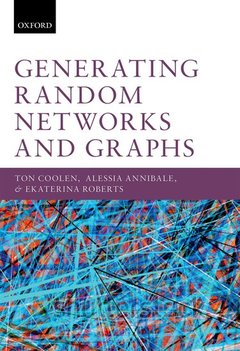Description
Generating Random Networks and Graphs
Authors: Coolen Ton, Annibale Alessia, Roberts Ekaterina
Language: English
91.54 €
In Print (Delivery period: 21 days).
Add to cart
Publication date: 03-2017
324 p. · 17.9x25.3 cm · Hardback
324 p. · 17.9x25.3 cm · Hardback
Description
/li>Biography
/li>
Generating random networks efficiently and accurately is an important challenge for practical applications, and an interesting question for theoretical study. This book presents and discusses common methods of generating random graphs. It begins with approaches such as Exponential Random Graph Models, where the targeted probability of each network appearing in the ensemble is specified. This section also includes degree-preserving randomisation algorithms, where the aim is to generate networks with the correct number of links at each node, and care must be taken to avoid introducing a bias. Separately, it looks at growth style algorithms (e.g. preferential attachment) which aim to model a real process and then to analyse the resulting ensemble of graphs. It also covers how to generate special types of graphs including modular graphs, graphs with community structure and temporal graphs. The book is aimed at the graduate student or advanced undergraduate. It includes many worked examples and open questions making it suitable for use in teaching. Explicit pseudocode algorithms are included throughout the book to make the ideas straightforward to apply. With larger and larger datasets, it is crucial to have practical and well-understood tools. Being able to test a hypothesis against a properly specified control case is at the heart of the 'scientific method'. Hence, knowledge on how to generate controlled and unbiased random graph ensembles is vital for anybody wishing to apply network science in their research.
Ton Coolen received his PhD in Theoretical Physics from the University of Utrecht, followed by postdoctoral work at Utrecht, Nijmegen and Oxford. Since 1995 he has been working at King's College London. During this time he had developed a special interest in multidisciplinary research. This is expressed firstly through applying his expertise in statistical mechanics to problems including medical survival analysis, cellular signalling networks, econophysics and immunology. He also set up the Institute for Mathematical and Molecular Biomedicine in order to bring together colleagues in biology, medicine, physics, computer science and mathematics to work on developing effective quantitative tools for biomedical researchers. Alessia Annibale obtained her undergraduate and Master degrees from the University of Rome "La Sapienza" before moving to the Disordered System and Neural Networks group in King's College London to complete her PhD. She has continued to work as a lecturer in King's College London, with papers published on spin glasses, network dynamics and stochastic processes on finitely connected random graphs. She is a member of the Institute for Mathematical and Molecular Biomedicine, and in recent years has taken a particular interest in applying the mathematical tools of disordered systems to understand the properties of biological networks. Ekaterina Roberts obtained her undergraduate degree from Imperial College, London. After this she worked at the UK's Financial Services Authority, contributing to regulatory policies on how financial institutions should measure and capitalise their credit risk, as well as undertaking direct supervisory oversight of some small banks and insurers. She then joined the Randall Division of Cell and Molecular Biophysics to complete a cross-disciplinary PhD which used statistical mechanics to create tools to analyse random graph ensembles which share topological properties with real molecular networks.
© 2024 LAVOISIER S.A.S.




